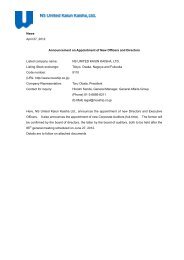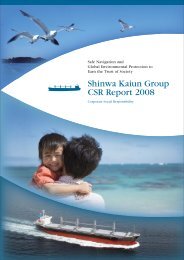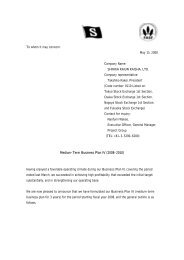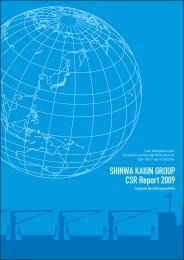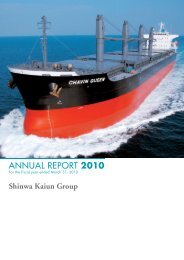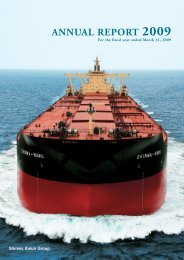SHINWA KAIUN GROUP CSR Report 2010
SHINWA KAIUN GROUP CSR Report 2010
SHINWA KAIUN GROUP CSR Report 2010
You also want an ePaper? Increase the reach of your titles
YUMPU automatically turns print PDFs into web optimized ePapers that Google loves.
Reducing Environmental Impact<br />
Environmental <strong>Report</strong><br />
Energy-Saving Devices<br />
Propeller Flow Optimization<br />
One of the most common systems for ship propulsion is the installation of propellers at the stern<br />
of the ship.These are turned using a diesel or other engine, propelling the ship forward or<br />
backward.<br />
Various efforts have been made to improve our vessels’ diesel engines, and fins to adjust the flow<br />
of water at the stern of the vessels have been adopted as energy-saving devices for more<br />
efficient propulsion.<br />
Ships are propelled via water being forced away from rotating propellers, with effective<br />
propulsion depending on the movement of water into and away from the propellers.<br />
To efficiently convert the flow generated by the propellers into propulsion, a fin or rudder<br />
designed to adjust the flow of water is installed either in front of or at the back of the<br />
propellers.<br />
The M/V SHIN-EI and M/V <strong>SHINWA</strong>-MARU, delivered in 2008, feature blades and protrusions<br />
adjusting the flow of water at the back of the propellers. The M/V YUGAWASAN, delivered in<br />
2005,features radial blades in front of the propellers, serving the same purpose.<br />
These enable a 3-8% increase in propulsion efficiency, thus improving fuel efficiency by 3-8%<br />
and reducing CO2 and other exhaust emissions.<br />
Energy-saving device mounted on the Yugawasan<br />
Energy-saving device mounted<br />
on the Shin-Ei and Shinwa-Maru<br />
Courtesy of Universal Shipbuilding Corporation<br />
Construction of New Energy-Saving Ships<br />
A newly built ship (a cement carrier) launched by Shinwa Naiko Kaiun Kaisha Co., Ltd., on April<br />
22, <strong>2010</strong>, has every available type of energy-saving fittings and equipment installed. This<br />
equipment has been approved as energy-saving by the Ministry of Land, Infrastructure, Transport<br />
and Tourism, so this vessel is effectively an "energy-saving ship" in accordance with Ministry<br />
standards. Shinwa Naiko Kaiun aims to achieve a further energy-saving effect by assigning this<br />
vessel to efficient routes in order to make full use of its superiority in terms of energy<br />
conservation hardware. Below are the principal particulars of this ship, along with an introduction<br />
to its energy-saving fittings and equipment.<br />
Fuyo Maru No. 6, the newly built energy-saving<br />
ship of Shinwa Naiko Kaiun Kaisha Co., Ltd.<br />
Principal Particulars and Energy-Saving Fittings on the Fuyo Maru No. 6<br />
Principal Particulars<br />
Total length 98.00m<br />
Width 16.00m<br />
Depth 8.50m<br />
Extreme draft 6.724m<br />
Gross tonnage 3,610t<br />
Deadweight tonnage 5,477mt<br />
Main Engine:<br />
Diesel 6UEC33LS II<br />
Output(horsepower)<br />
2,721kW(3,700PS)<br />
Energy-Saving Fittings and Equipment<br />
1 Shaft generator<br />
2 Radial blades mounted before<br />
propeller(energy-saving stators)<br />
3 Variable-pitch propeller<br />
4 Fins mounted on propeller boss<br />
(propeller boss cap with fins)<br />
5 Exhaust gas economizer<br />
6 Main engine coolant heat recovery<br />
unit(central plate cooler)<br />
16Shinwa Kaiun Group <strong>CSR</strong> <strong>Report</strong> <strong>2010</strong>


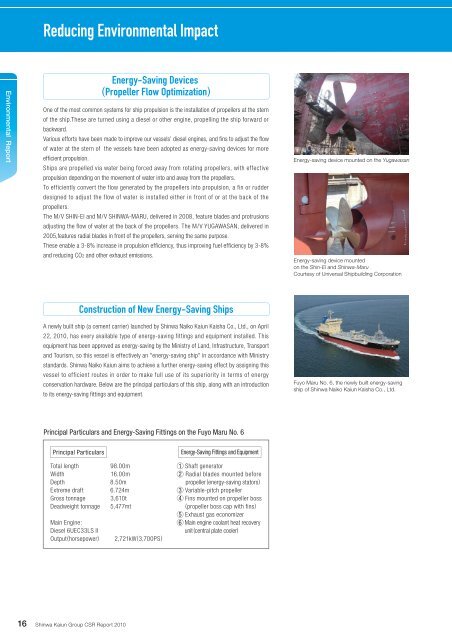
![[Consolidated] Balance Sheet (B/S)(PDF/35KB)](https://img.yumpu.com/49745625/1/184x260/consolidated-balance-sheet-b-spdf-35kb.jpg?quality=85)
